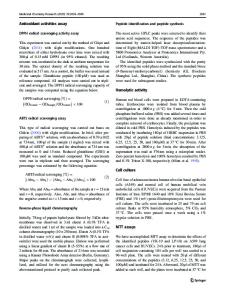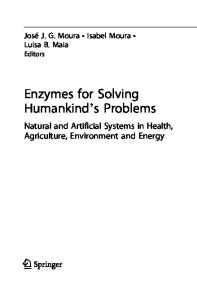Assembly of Nanoparticles from Bioactive Peptides and Chitosan
- PDF / 226,540 Bytes
- 6 Pages / 432 x 648 pts Page_size
- 54 Downloads / 300 Views
Assembly of Nanoparticles from Bioactive Peptides and Chitosan B. Hu,1,2 Q. R. Huang, 1 and X. X. Zeng, 2 Department of Food Science, Rutgers University, 65 Dudley Road, New Brunswick, New Jersey 08901, USA; 2 College of Food Science and Technology, Nanjing Agricultural University, Nanjing 210095, People’s Republic of China; 1
ABSTRACT Assembly of nanoparticles from bioactive peptides, caseinophosphopeptides (CPPs) and chitosan (CS) at physiological conditions and various CS/CPPs mass ratios have been systematically studied using a combination of turbidimetric titration, dynamic light scattering (DLS), electrophoretic mobility (zeta-potential) and transmission electron microscopy (TEM). Peptides, incorporated with CS forming nanoparticles, have already been prepared and identified using liquid chromatography-tandem mass spectrometry (LC-MS-MS). They are characteristic with different amount of clusters of phosphorylated seryl residues. At low salt concentration, an increase of CS/CPP mass ratio shifted the critical pHij1, which designated the formation of CS/CPP nanocomplexes, as well as pHmax, representing the neutralization of positive and negative charge to higher pH values. The peptide-polymer binding mechanism was analyzed according to the results of DLS, electrophoretic mobility, and TEM. First, negatively charged CPPs absorbed to positively charged CS molecular chain to form intrapolymer nanocomplexes saturated with CPPs (CPPNP). Then, the negatively charged CPPNP was bridged by added positively charged CS. Finally, novel nano-scaled spherical brushes were formed as additional CS molecule absorbed back to and bound the CPPNP. Phosphorylated groups in the CPPs might be the dominant sites for interaction with –NH3+ on the CS molecular chain. INTRODUCTION Recently, significant efforts have been devoted to investigate the assembly between polyelectrolyte and protein forming different hierarchical supramolecular structures on the nm– ȝm length, such as coacervates, multilayers and brushes1-3. A number of non-covalent forces can contribute to complex formation between polymers and proteins, among which, the predominance of electrostatic interaction is widely accepted. Furthermore, the Voorn–Overbeek, Veis–Aranyi theories as well as their modifications have already been brought forward focusing on the mechanism of the interaction between polyelectrolyte and protein3,4. However, as the constitution elements of protein, the detailed information about the interaction between natural peptides and polyelectrolyte as well as the corresponding interaction model has been scarcely reported. Food is a fascinating and important material, making up some of the most complex examples of soft condensed matter (SCM) with which we interact daily5. It is a natural resource of biopolymer soft materials, not only biodegradable and biocompatible, but also biofunctional6,7. Tryptic digestion of the casein proteins yields caseinophosphopeptides (CPPs) from the N terminus polar region, which contains clusters of phosphorylated seryl residue
Data Loading...











